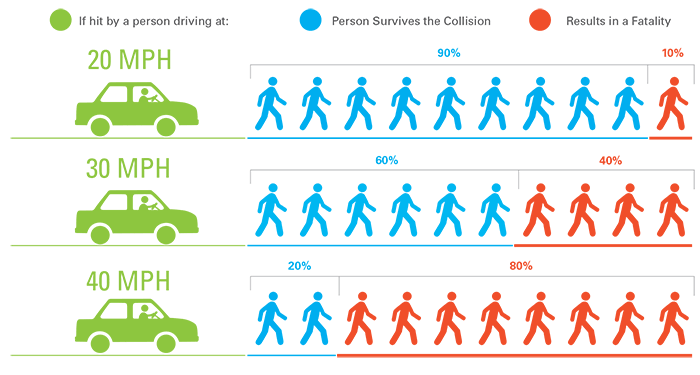
By Ben Crowther
Around the country, governments are taking steps to retrofit their fleets with intelligent speed assistance (ISA), an inexpensive technology that helps drivers maintain posted speed limits and drive safely. Will your community be next?
Earlier this month, America Walks kicked off the Safer Fleets Challenge, calling on cities and towns to install ISA on their fleets. The goal: 50 governments taking action to adopt ISA by 2025.
Speeding is a major cause of deaths and serious injuries on American roadways and one of the main reasons why pedestrian deaths have increased by 62% since 2009. We need to make our streets safer, particularly for people outside of cars, and the adoption of ISA provides one way forward.
ISA systems are now required in new cars across Europe and have been tested on city-owned vehicles in New York City and other places. These systems use either GPS or road-sign recognition cameras to detect the current speed limit. If the driver surpasses the speed limit, the ISA system either issues a warning to slow down or automatically adjusts the car’s speed by throttling the engine. However, motorists can temporarily override the system to pass.
The adoption of ISA isn’t a silver bullet for dangerous driving, but it contributes to a comprehensive Safe Systems Approach that prioritizes safer street design, safer speeds, and safer vehicles. ISA adds another layer of redundancy to protect all the people on our roads and for government fleets, it represents a concrete commitment to safety.
Want to join the Safer Fleets Challenge? Hear from our webinar panel experts Amy Cohen, Cathy Chase, and Jorge Bonilla on how you can make the case to get your government to adopt ISA.
Addressing the Crisis of Speed and Traffic Violence
Nine years ago, 12-year-old Sammy Cohen Eckstein was killed crossing the street in his New York City neighborhood by a driver speeding at nearly 40 mph. His mother Amy Cohen founded the organization Families for Safe Streets to push for legislative and policy changes that address the traffic violence claiming tens of thousands of lives every year.

Fast driving fuels the crisis of traffic violence. Only 1 out of every 5 pedestrians struck by a car at 40 mph will walk away alive. At 20 mph, 9 out of every 10 pedestrians survive. Speeding factored into 29% of fatalities in crashes in 2021, for a total of 12,330 people killed. The emotional and financial toll of these crashes is high.
So when Families for Safe Streets first heard about the potential for an ISA pilot program for New York City’s Fleet, they came out in strong support. Since the launch of New York City’s ISA pilot program in August 2022, vehicles utilizing the technology have driven over 133,400 miles and successfully traveled within speed limit 99 percent of the time. Use of ISA technology also reduced hard braking events, often an indicator of unsafe driving, by 36 percent. “There’s no question that it works,” said Cohen. “This is a technology that should be in every vehicle across the country.”
Government at All Levels Needs to Take Action
Local governments aren’t the only ones who have the power to take action. Cathy Chase, President of Advocates for Highway and Auto Safety, called on the federal government to require ISA not just for its own fleets, but for all cars in the United States. “At a time when fatalities are skyrocketing on our roadways, we should be using every tool that has been proven to be effective in reducing crashes, like ISA.”
ISA aligns closely with the US Department of Transportation’s Safe Systems Approach and advocates should be vocal about getting it as well as other life-saving technologies like Automatic Emergency Braking made standard in all vehicles. The goal, while ambitious, is far from hypothetical. Early House versions of the infrastructure bill included ISA requirements, but they were cut from the final version. “We haven’t given up,” said Chase “and we firmly believe that a federal requirement is needed in order to get this technology into all cars.”
In the meantime, local governments that accept the challenge generate more and more data showing the impact of ISA and help build the case to federal regulators that all cars should come equipped with it by law.
Watch the Full Webinar Here:
The Fleet Manager Perspective
Jorge Bonilla, fleet operations manager for Ventura County in California, realized he had a problem. To better track mileage and fuel data, Ventura County had installed telematics on its vehicles. The telematics system also tracked speed data, which Bonilla found eye-opening. County employees were consistently driving their vehicles at dangerous speeds, with one driver clocking in at 103 mph on a highway and several speeding 50-60 mph through school zones. Bonilla, who has made safety his fleet’s top priority, knew something had to be done.
Because he manages vehicles, not drivers, Bonilla started to explore technologies that maintain safe speeds. He was impressed with ISA since it required drivers to adhere to posted speed limits as they changed, unlike speed governors that only set a top speed for the vehicle. So he decided to start an ISA pilot program for the county fleet.
To date, the results have been overwhelmingly positive. Like in New York City, instances of speeding in ISA-equipped vehicles have dropped to near zero. Department managers endorse ISA because they no longer have to manage speeding violations or worry about their drivers traveling at unsafe speeds. Ventura County’s pilot program continues to grow, with another 80 vehicles retrofitted with ISA.
Ventura County hasn’t had the opportunity to analyze fuel consumption from ISA-equipped vehicles yet, but others have. Case studies show a 10.5% increase in fuel economy for vehicles using ISA with acceleration control in combined urban and rural settings. Reduced fuel use resulted in an annual cost saving of $1,867 per vehicle, meaning ISA retrofits pay for themselves.
Join the Safer Fleets Challenge!
Ready to be the next community to join the Safer Fleets Challenge? We have some resources to help, including a Challenge Fact Sheet and template resolution/executive order you can share with your decision makers. Once you’ve started your effort, let us know! Contact Ben Crowther, America Walks’ advocacy manager, to explore collaborative opportunities and exchange ideas for organizing your local campaign.